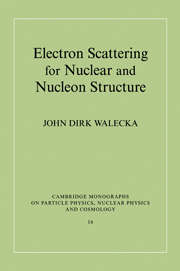30 - Other facilities
from Part 5 - Future directions
Summary
The previous and subsequent chapters go into detail on TJNAF (CEBAF) because that is the project in which the author was most deeply involved and about which he is most knowledgeable. Many other accelerator laboratories have played, and continue to play, an important role in electron scattering studies of nuclei and nucleons. Worth highlighting from the early years are the Nuclear Physics Laboratory at the University of Illinois, where the betatron provided a tool to do the very first study of nuclear structure with electrons [Ly51, Il87], and the High Energy Physics Laboratory at Stanford (HEPL), where Hofstadter carried out his pioneering work on charge and magnetization densities [Ho56, Ho63]. Many other important facilities sprang from the work at HEPL, including those at Amsterdam, Darmstadt, Mainz, Saskatchewan, Tohuko, and the Saclay Laboratory, which played a particularly important role in the development of the field. The Stanford Linear Accelerator (SLAC), under Wolfgang Panofsky's inspired leadership, found its roots in HEPL, as did TJNAF. A prototype of the CEBAF superconducting accelerator was first constructed at HEPL. An excellent discussion of the early years of electron scattering is to be found in [I187].
It is the Bates Laboratory at M.I.T., where a variety of precision experiments truly demonstrated the power of electron scattering to study the nucleus, and the Stanford Linear Accelerator Center (SLAC), where high-energy experiments demonstrated the pointlike, asymptotically free, substructure of the nucleon and examined its weak neutral current, that are responsible for the role that electron scattering plays in nuclear and particle physics in the U.S. today.
The principal centers today for nuclear structure studies with electrons are TJNAF in Newport News, the Bates Laboratory at M.I.T. in Boston, and the Mainz Microtron (MAMI), in Germany.
- Type
- Chapter
- Information
- Electron Scattering for Nuclear and Nucleon Structure , pp. 272 - 277Publisher: Cambridge University PressPrint publication year: 2001



